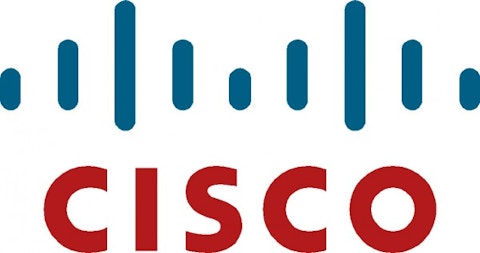On this day in economic and financial history …
On Feb. 16, 1990, just five years after its founding in a San Francisco garage, Cisco Systems, Inc. (NASDAQ:CSCO) went public on the Nasdaq stock exchange at a market capitalization of approximately $150 million. Investor interest quickly picked up in this young networking dynamo, and within a year its market cap, it had grown by 400%. Throughout the 1990s, Cisco would remain one of the hottest names in high-tech. A Fortune feature at the end of 1995 hailed it as “one of the great investment plays of a lifetime” when an IPO-day investment had already gained about 6,000%. Its consistency in beating expectations was seen as ironclad: “[D]uring its first few years as a public company, Cisco used to carry such a large backlog of orders that executives had actually been able to predict on the day the quarter began by how much the company would beat analysts’ earnings estimates.”

Let’s chat
Cisco’s key technologies might have helped push the rapid growth of the Internet, but many key developments in Internet history took place before Cisco was ever formed. For example, ARPANET, the networked predecessor to the Internet, has been around since 1969, and the very first networked bulletin board system was born in the middle of a blizzard on Feb. 16, 1978, before the PC ever existed.
That bulletin board was the brainchild of Ward Christensen and Randy Seuss, who came together (in typical programmer fashion) to develop a way for members of their group of Chicago-area computer hobbyists to post notes for each other without having to leave their houses in a snowstorm. The pair developed a server and software that allowed others to dial into it from their modems to read threads and post updates — essentially the same thing millions of people do every day around the world, and which you can do right now if you’d like by scrolling down and sharing your thoughts in the comments section of this article.
Of course, Ward and Randy’s setup was far more primitive than the Reddits and other message boards we’re used to. Besides lacking even the simple framework of MS-DOS, the first message board colonists had to dial into the server with a maximum speed of 1.2 kilobits per second. To put that in perspective, most half-decent cable modem services now offer download speeds nearly 900 times faster, if not thousands of times faster. If you were trying to read this on Ward and Randy’s bulletin board, you’d have to wait more than a minute for it to load.
Help comes for the small farmer … in theory
On Feb. 16, 1938, President Franklin D. Roosevelt signed that year’s Agricultural Adjustment Act into law. It was, in the words of The New York Times, “the most ambitious farm relief experiment the nation has ever attempted.”
The act was devised in response to the Supreme Court’s rejection of a 1933 law of the same name. In that case, the court had found it unconstitutional to tax companies processing the output of farms only to redistribute these taxes back to the farmers in the form of subsidies. The court held that agricultural regulation should be left to the states. The act of 1938 remedied this problem by making the subsidies a direct government outlay instead of a recycling of processor taxes, which at the time were anticipated to generate about $200 million in annual revenue for the federal government.
Roosevelt commented on signing that his national farm policy was “to assure to agriculture a fair share of an increasing national income, to provide consumers with abundant supplies of food and fiber, to stop waste of soil, and to reduce the gap between huge surpluses and disastrous shortages.” The act’s passage, Roosevelt said, represented the “winning of one more battle for an underlying farm policy that will endure.”
He was right. The act undergirds much of the federal government’s current agricultural policies, although in many places it has been augmented or superseded by more recent legislation. Its latest descendant, the Food, Conservation, and Energy Act of 2008 (also known as the Farm Bill), provided $284 billion over five years to various agricultural programs, including about $42 billion for commodity crop subsidies, $189 billion for nutrition programs, $24 billion for conservation, and $22 billion for crop insurance. The act was extended during the 2012 fiscal cliff talks but will expire this coming fall.
Revving those profit engines
On Feb. 16, 1989, Ford Motor Company (NYSE:F) reported what was then a record auto-industry annual profit of $5.3 billion for its 1988 fiscal year, less than a week after General Motors Company (NYSE:GM) reported a short-lived record profit of its own of $4.9 billion. Ford’s record was the more impressive, as it managed to earn more profit despite 16% less revenue for the year. Ford was also by far the most impressive grower of the Big Three automakers, as it had increased annual profit by 83% since 1984, as compared with GM’s tepid 9% five-year gain and Chrysler‘s four straight years of shrinking earnings.
Thanks to Ford’s record year, the Big Three combined for an industry record of $11.3 billion in net income, driven by strong overseas performances. This performance helped ease worries that the industry might have peaked, but it wouldn’t last long. Ford’s net income would fall throughout the early ’90s before bottoming out in negative territory in 1992. However, several years later, as the dot-com boom made everyone rich, Ford reached record net levels of net income that have yet to be surpassed. Prosperity is rarely consistent in the auto industry.
The article Cisco’s Big Debut and Ford’s Record-Breaking Performance originally appeared on Fool.com and is written by Alex Planes.
Fool contributor Alex Planes holds no financial position in any company mentioned here. Add him on Google+ or follow him on Twitter, @TMFBiggles, for more insight into markets, history, and technology.The Motley Fool recommends Cisco Systems, Ford, and General Motors and owns shares of Ford.
Copyright © 1995 – 2013 The Motley Fool, LLC. All rights reserved. The Motley Fool has a disclosure policy.




